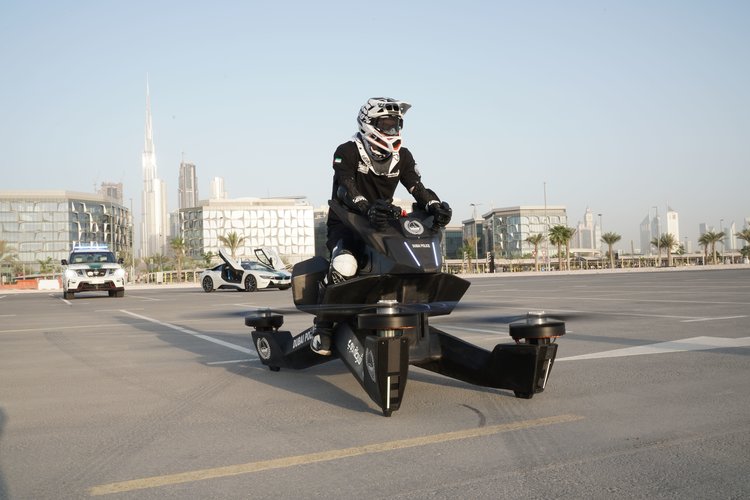The world’s first Hoverbike: Q&A with Hoversurf’s Joseph Segura-Conn
The world’s first hoverbike, Hoversurf’s Scorpion 3, did not have the smoothest of landings when it entered the industry at GITEX 2017, Dubai’s annual tech expo. The model came under instant scrutiny for its four propellers, whose proximity posed safety risks to the riders. But the Dubai Police loved it.
Hoversurf produced a Hoverbike S3 exactly a year later – for the Dubai Police – except, this one looked like a completely different bike. Reinforced with custom-built, carbon-fibre parts, the vehicle now has protective panels in-front-and-behind the rider’s legs. It also comes with propeller guards, which are not showcased in the official images – because they’re all professional pilots riding them.
However, Joseph Segura-Conn, Chief Operating Officer of the California-based technology company, says the guards protect the rider from the surroundings, like training wheels on a bicycle. “The training wheels don’t really stop you from falling over, your legs do that,” he said.
In its four-year journey from inception to execution, five Hoverbike Scorpion 3s have been delivered to the Dubai Police. Personnel are now being trained to use them.
Aside from that, start-up Hoversurf has raised $3 million, created two heavy-lift cargo drones and has nearly completed building a two-person hovercar.
Segura-Conn spoke to VTOL Investor about the ins and outs of the S3, the future of VTOL taxis and his company’s next big project.

Hoversurf delivered five Hoverbikes to the Dubai Police. Courtesy: Hoversurf
VTOL Investor: Has there been more consumer interest, aside from Dubai Police, for the Hoverbike Scorpion 3?
Joseph Segura-Conn: Yes. We’ve opened the pre-order process, and we’ve already received orders from the United States, Canada, Italy and Japan. We have not delivered any yet, because we’re currently raising our next round of money. But our main focus is ‘Special Use’ cases, so: Police Force, Special Forces – ‘Search and Rescues’. We’re not a hoverbike manufacturing company, so we will only sell a handful every year.
VTOL Investor: What kind of training should riders have before they ride the vehicle?
Joseph Segura-Conn: If someone purchases a vehicle, we require them to complete a three-day course. That course is taken here — we fly them out — and they have to spend almost a whole day learning all the functions. We want the person that buys the vehicle, to almost be able to build the vehicle. If you’re a helicopter or airplane pilot, you need to know how every single part works, before you can fly it. We follow a similar certification and process as you would with having a pilot’s license.
The first day is learning the functions and safety procedures, in case of an emergency. On the second day, they’ll ride the vehicle and get in the air. The first couple of hours, similar to learning to ride a motorcycle, will normally freak you out. Because you’re still learning to stop and go. But once you do it some more times, you’re comfortable, excited and eager to get on it. So, it’s the same thing.
If the team, which includes a professional pilot, feels that the buyer is not up to par to fly the Hoverbike, then we require the buyer to continue taking the course until they complete it. Or if they complete it sooner, they’re good to go.
VTOL Investor: The Hoverbike Scorpion 3 weighs exactly 114kg, which is the legal limit for Ultra-Light Vehicles. Did you always intend to build an ultra-light vehicle?
Joseph Segura-Conn: Yes, we wanted to enter the market as an ultra-light vehicle, because UL is like the FAA’s inventor’s platform. The FAA wants to keep it open, so that people can innovate new vehicles. So, from last year’s version to this one, it’s almost like we started from scratch. It’s almost like a 1950s car to a 2019 Ferrari. We now have custom-built parts, not to mention the carbon fibre exterior, to make it as light and strong as it can possibly be. Having it in the UL category also means that buyers do not need a pilot’s license to ride the vehicle.
VTOL Investor: Are you concerned about the noise levels of technology used by the Hoverbike S3?
Joseph Segura-Conn: The noise level for the Hoverbike S3 is 80 decibels. It is pretty quiet. We use a tri-blade propeller which reduces the sound emitted. For ultra-light aircraft propellers, the noise isn’t really an issue, but we understand that when it comes to a taxi vehicle, that is an issue. And so, we haven’t disclosed too much information to the public, but we have a patent for something called a ‘Venturi Engine’. It’s an electric ducted fan, which will have significantly lower noise levels. There is no legal sound level for an ultralight vehicle. It is something we considered, but it’s not something that’s detrimental to the sales of the Hoverbike. When it comes into the urban environment, things will have to change.
VTOL Investor: How long until we have VTOL taxis?
Joseph Segura-Conn: There’s a big difference between taxi vehicles and personal ones. Personal vehicles just require you to be using the vehicle in the proper area safely. You want to make sure the pilot understands how to fly it. It’s a simpler process.
When you start to carry 2-5 people and you’re moving hundreds of feet over populated areas, there are a lot of different factors to consider. It’ll take several years for certification, not to mention hundreds of millions of dollars. There are FAA regulations that haven’t even been created for this yet. So, the technology is already here. But the regulation and the safety aspects mean we need more time before it’s going to be commercially available, for the public.
VTOL Investor: In a sentence, could describe your next project, ‘Project Formula’?
Joseph Segura-Conn: ‘Project Formula’ is the first personal hovercar.
Subscribe to our free newsletter
For more opinions from Helicopter Investor, subscribe to our email newsletter.






